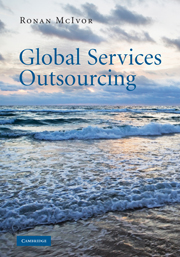Book contents
- Frontmatter
- Contents
- List of figures
- List of tables
- List of illustrations
- Acknowledgements
- 1 Introduction
- 2 Global services outsourcing overview
- 3 Making the services outsourcing decision
- 4 Location and sourcing model choice in global services outsourcing
- 5 Managing global services outsourcing arrangements
- 6 Creating shared services arrangements
- 7 Services outsourcing and performance management
- 8 Services outsourcing and the spin-off arrangement
- 9 Learning from failure and strategies for recovery in business process outsourcing
- 10 Conclusion
- Glossary
- Index
- References
5 - Managing global services outsourcing arrangements
Published online by Cambridge University Press: 05 June 2012
- Frontmatter
- Contents
- List of figures
- List of tables
- List of illustrations
- Acknowledgements
- 1 Introduction
- 2 Global services outsourcing overview
- 3 Making the services outsourcing decision
- 4 Location and sourcing model choice in global services outsourcing
- 5 Managing global services outsourcing arrangements
- 6 Creating shared services arrangements
- 7 Services outsourcing and performance management
- 8 Services outsourcing and the spin-off arrangement
- 9 Learning from failure and strategies for recovery in business process outsourcing
- 10 Conclusion
- Glossary
- Index
- References
Summary
Introduction
Organisations are often drawn to global services outsourcing to avail of the potential labour cost savings. However, organisations fail to take account of the transaction costs involved in managing global services arrangements. Transaction costs are difficult to measure objectively, and are much higher than those associated with domestic outsourcing as a result of differences in culture, language and time zone and of geographic distance. Cultural differences can lead to communication difficulties between client and vendor personnel, which can adversely impact service quality levels. In addition, where the vendor is in a different time zone, the client will have to employ project managers in different shift patterns to manage the vendor, which is an additional cost over domestic outsourcing. These transaction costs can offset any gains from savings on labour costs, and also lead to service quality problems.
An area where the global services outsourcing phenomenon has had a significant impact has been that of software development. Many software development projects now involve teams of people from the client and vendor working together, speaking a variety of languages, and separated by time and geographic distance. Although global software development can deliver reduced development times as a result of ‘follow-the-sun’ working, and of access to a highly skilled and lower cost labour pool, it presents significant challenges. The lack of face-to-face interaction between client and vendor personnel separated by geographic distance can lead to breakdowns in communication and misunderstandings in client requirements.
- Type
- Chapter
- Information
- Global Services Outsourcing , pp. 114 - 148Publisher: Cambridge University PressPrint publication year: 2010



